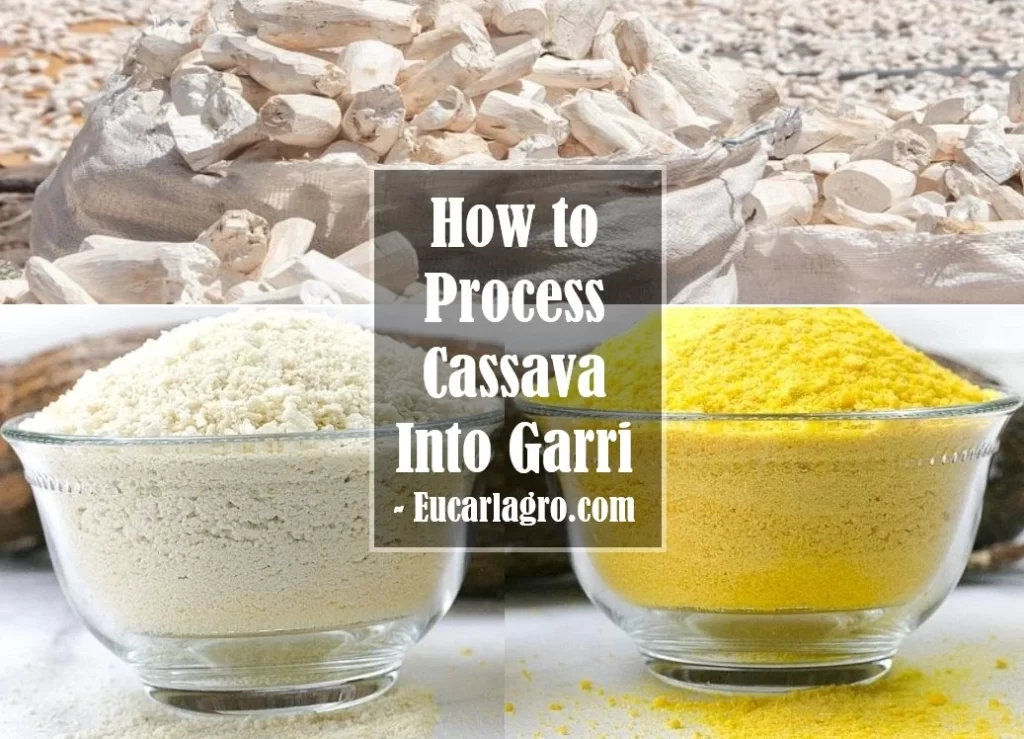How to Process Cassava Into Garri
How to Process Cassava Into Garri: Cassava (Mandioca), a tuber crop, is used in the preparation of garri. Cassava flake is one of the most popular dishes made from the processing of Cassava. It is abundantly farmed and a staple meal. There are many other uses for it, including food processing and commercial applications.
Like Fufu, the preparation of gari (cassava flakes) from cassava is similar to that of other food products manufactured from it (Akpu or Santana).
Bobozee (also known as Abacha Mmiri) and cassava chips can be made from cassava flakes.
Garri: An Overview
In West Africa, cassava tubers are used to make a popular dish known as garri (also known as, Garry, gali, or tapioca). People in Nigeria, Sierra Leone, and Cameroon use gari, while people in Togo and Benin refer to it as gari.
Nigeria is a major exporter of this valuable cash crop. It has a high carbohydrate content and is processed in a variety of methods to produce an edible product.
Gari is a creamy-white or light-yellowish flour with a subtle fermented flavor when it is first ground up for use.
IjebuGari (from the Ijebu people in Ogun state) is a white Gali variety. Yoruba people of Ijebu origin in Nigeria are the primary producers of this type of wine. Infusing/drinking it is fantastic because of its sour flavor.
If you make your own tapioca, you know exactly what you’re eating because it’s free of sand and stone. Preparing a minimal amount for your immediate family is always the best option.

Types of Garri
There are basically two types of garri, they are:
The Gari White
The Gari in Yellow
However, the yellow one can be obtained by adding a few drops of palm oil (mmanunri) to the wet cassava flour during the frying or drying step, which is the same for both Gari kinds.
Garri can be made at home using cassava tubers, which can be used to make eba and snacks with a few seeds of groundnuts.
How to Process Cassava Into Garri Traditionally
In order to make Process Cassava Into Garri at home, the following processes must be followed:
Cassava tubers should be harvested from the farm and transported home or to the place of processing. These tubers can be purchased at any local market, and this is the first step in the procedure.
In order to begin, the cassava tubers must first be peeled away from the root. Try to avoid going too deep when peeling. Do this for every single one of the cassava tubers.
Wash the tubers after peeling them. When washing tubers for the first time, use a lot of water.
Third, evenly crush the tubers by cutting them into medium-sized pieces.
Finally, and most critically, mill them in a large grinding machine (often a horizontal one). It is possible to grate cassava tubers at home if they are tiny enough but that can be tedious especially if the quantity of the tubers is many.
In the next step, the cassava paste is sealed in a bag and drained for two or three days to remove excess moisture (fermentation occurs at this stage).
The fine cassava powder can next be separated from other particles using a large sieve.
After that, use a thick frying pan to stir fry the cassava powder in a reasonable amount until it dries out and turns brittle. For a more yellow gari, use a few drops of red palm oil every now and then.
In the end, keep your gari in a dried, cool location and enjoy your dinner.
Tag: Process Cassava Into Garri

![How to Start Crayfish Business In Nigeria ([year]) Start Crayfish Business In Nigeria](https://eucarlagro.com/wp-content/uploads/2023/11/Start-Crayfish-Business-In-Nigeria.jpeg)
